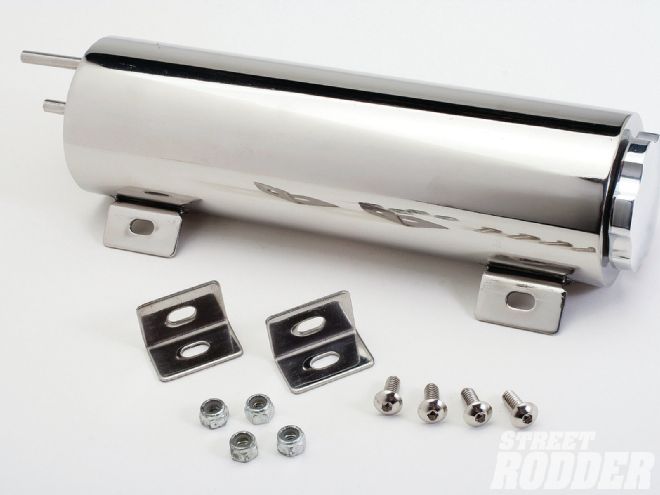
Here we are entering another street rod season and hot rods across the country are preparing for the open road. Preparing your street rod for another trouble-free season is time well spent and should include such things as fresh brake fluid, checking brake pads and tires, oil change, and don’t forget the all-important cooling system.
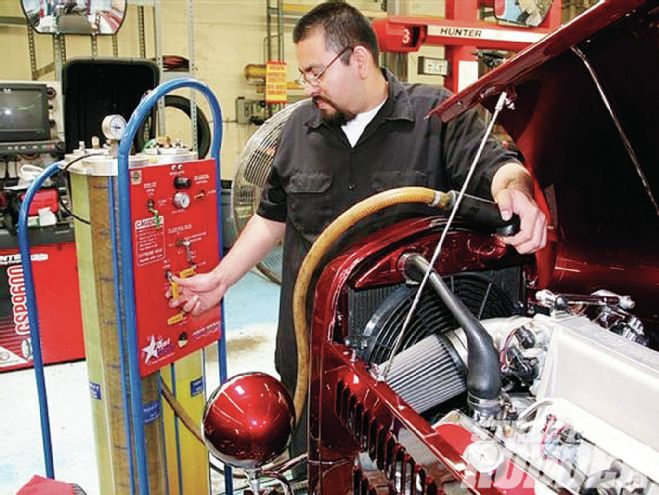 Scale and minerals can build up in your engine, drastically affecting the cooling of the motor. The best way to remove said deposits is with a commercial coolant flush. Not only does this superclean the system, the professional shop can also handle the safe recycling of your old coolant.
Scale and minerals can build up in your engine, drastically affecting the cooling of the motor. The best way to remove said deposits is with a commercial coolant flush. Not only does this superclean the system, the professional shop can also handle the safe recycling of your old coolant.
When we talk about cooling systems many hot rodders tend to think simply of the radiator and coolant within, but there are other factors to consider when designing, maintaining, or upgrading your car’s cooling system. Many factors contribute to efficiently cooling your motor, and they involve water, oil, and air.
The major cooling system in your street rod is the radiator and coolant, and while you may have filled it with the best coolant money can buy, if it is over three years old it is time for a coolant change. Prior to the change it pays to run a flush through the entire system by running the car up to temperature and then draining the coolant into a safe container and disposing of it at your local recycling center, or even better, take the car in for a professional coolant flush. These flushes will remove all the built-up scale and mineral deposits in the motor and radiator, and provide a nice clean surface for the transfer of engine heat to the water.
The key to good cooling is efficient heat transfer, and the key to good heat transfer is clean internal surfaces and coolant treated with chemical surfactants such as AMSOIL INC. Coolant Boost. A surfactant reduces the surface tension of water and antifreeze in the cooling system. This reduced surface tension allows closer contact with metal parts. With more contact with metal surfaces, the coolant does a better job of moving heat away from hot engine parts, and finally to the atmosphere via the radiator and fan. Coolant Boost also prevents unwanted mineral and scale buildup, and provides a lubricant for your water pump. For street rods, the Coolant Boost is used in conjunction with a high-quality 50/50 mix of antifreeze and water.
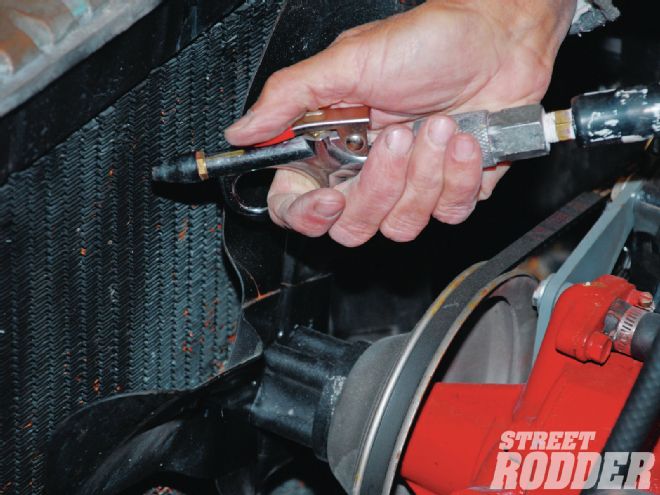 At least once a year use either an air hose or a water hose and reverse flow the fins of the radiator. This will clear dirt and debris that is lodged between the fins of the radiator, ensuring you have maximum airflow.
At least once a year use either an air hose or a water hose and reverse flow the fins of the radiator. This will clear dirt and debris that is lodged between the fins of the radiator, ensuring you have maximum airflow.
In simple terms here is how the typical cooling system works. Your water pump (or pumps for Flathead lovers) circulate the water through the engine and back through the radiator. The water is running through channels in the block to extract the heat from the engine. The coolant enters the engine cool and leaves hot; the idea is to have the coolant enter as cool as possible and leave as hot as possible, providing maximum heat transfer. The thermostat will speed or slow the coolant’s movement through the motor to maintain the desired temperature. Generally speaking most cooling systems work best with a thermostat.
When the hot coolant enters the radiator the tubes and fins become hot. The trick to a good radiator is having enough fin and tube surface to absorb heat and enough of an air gap between the fins to allow the cool air flowing through the radiator to dissipate the heat into the outside air. That is the major portion of cooling your car, but other pieces of the cooling puzzle are at work here, too.
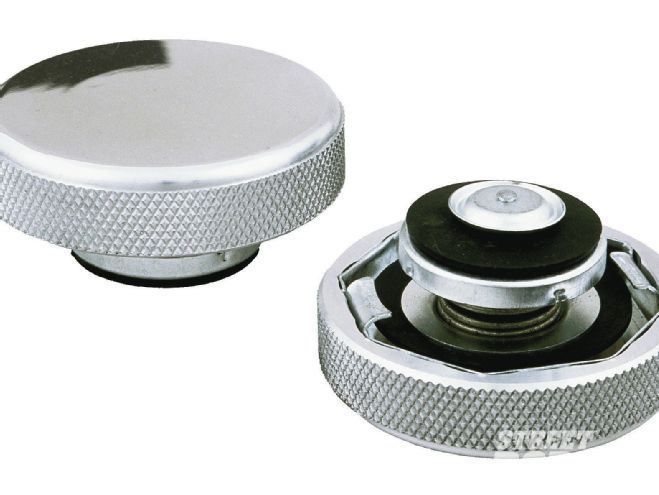 Examine the condition of your radiator cap during this routine maintenance. A faulty radiator cap can cause overheating by not maintaining the desired pressure, which will allow the coolant to boil at a lower temperature.
Examine the condition of your radiator cap during this routine maintenance. A faulty radiator cap can cause overheating by not maintaining the desired pressure, which will allow the coolant to boil at a lower temperature.
While the primary function of your motor oil is to lubricate the engine, it, too, acts as a coolant. Modern motors often employ oil sprayers on the bottom side of the pistons to help cool them on the combustion cycle and high-quality synthetic oil such as AMSOIL INC. will absorb and dissipate heat more efficiently than conventional organic oils. Since oil does a good job of cooling your motor, it only makes sense to cool your oil. An external oil cooler goes a long way to saving your engine and helping to maintain operating temperatures. The cooler and associated lines also add oil capacity and cooling to your engine. If possible, locate the oil cooler in a cool air stream or by using one of the aftermarket oil coolers with an electric fan. You can mount it anywhere and have effective oil cooling. Simple things like keeping the exterior of the oil pan clean also help dissipate heat from your oil.
The final piece of the cooling equation is air; without air circulation it is impossible to cool an engine. Even if you added a 55-gallon drum of coolant to the system, if you can’t remove the heat from the coolant, it is only a matter of time before the coolant reaches the boiling point. Your cooling system should include a high-quality radiator designed for the cubic inches engine and horsepower rating of the motor. Copper fins transfer heat faster than aluminum, but aluminum is lighter and the welded feature may be stronger. The choice is yours but a high-quality radiator of either material should do the job. Avoid using radiators from later model cars that have plastic tanks. The tanks do not transfer heat well and are generally a source of leaks with age.
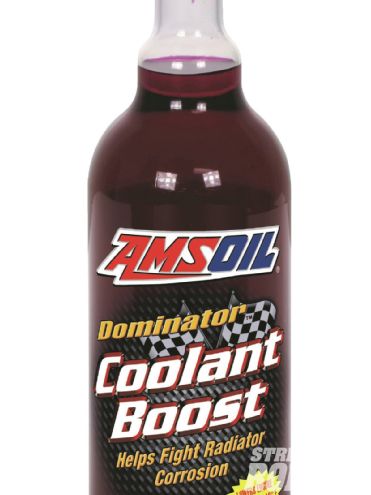 Coolant Boost by AMSOIL INC. has a tiered surfactant that actually reduces the surface tension of water at a lower temperature than most other brands of cooling additive. The three-tier surfactants work as the temperature increases.
Coolant Boost by AMSOIL INC. has a tiered surfactant that actually reduces the surface tension of water at a lower temperature than most other brands of cooling additive. The three-tier surfactants work as the temperature increases.
There have been some interesting innovations in radiator design in recent years. Flex-a-lite has incorporated finned tanks on their radiators that vastly increase the cooling surfaces, but that’s not all. Inside the Flex-a-lite tank, fins are attached to the tank, effectively absorbing heat and transferring it to the tank surface. These innovative tanks have proven to give increased cooling capacity without increasing the size of the radiator.
Excessively painting a radiator will lower the efficiency of the unit and at least once a year use compressed air or a water hose to blow through the radiator from the engine side of the radiator. This reverse flow will dislodge all the debris that has collected in between the fins of the radiator, and you will be amazed at the amount of dirt, sand, bug carcasses, and other litter that comes out of the fin area.
So now that you have the coolant flowing through a clean engine and modern design radiator, what is the best way to provide airflow through the radiator? Early hot rods relied on a mechanical fan attached to the motor, and if you are building a very traditional hot rod that is the only appropriate fan. Hot rodders quickly moved from the conventional four-blade steel fan to lightweight stainless steel (and in some cases fiberglass) fans that are known as flex fans because the blades would cup a lot of air at low speed, then flatten out at higher rpm to minimize horsepower drain and air turbulence behind the radiator. These fans are still available and are far superior to factory fans.
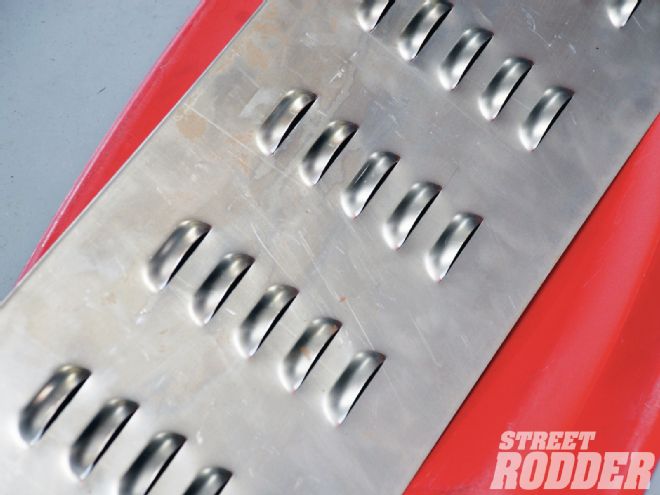 The best coolant, radiator, and fan in the world can’t work if you cannot move the appropriate amount of air through the radiator and out of the engine bay. Louvers will help exit hot air, which increases coolant efficiency and also allows more heat transfer from the entire engine block.
The best coolant, radiator, and fan in the world can’t work if you cannot move the appropriate amount of air through the radiator and out of the engine bay. Louvers will help exit hot air, which increases coolant efficiency and also allows more heat transfer from the entire engine block.
Today most cars are cooled with an electric fan and shroud attached to the radiator. The shroud is all-important to ensure the cooler, outside air is being forced through the radiator. Electric fans from companies like Flex-a-lite or Cooling Components are remarkably thin and move a huge volume of air to ensure good cooling. Flex-a-lite offers both single and dual fan applications with built-in shrouds.
Now, there is just plain old heat dissipation from the engine block itself. On some high-end builds it has become fashionable to grind the entire block smooth, paint it with a high-quality primer, sand it, and then do a basecoat/clearcoat on the block for that supersmooth look. All that is fine, but bear in mind when you smooth a block you are reducing the surface area of that block significantly and all that casting texture you are grinding off the block is also surface area for heat dissipation. Likewise applying multiple coats of paint on a block is effectively insulating it from outside air contact. For those reasons I never grind a block smooth (and well, there is also the fact that this writer can’t imagine grinding on an engine block for a week) and good engine enamel is all that is required to cover the block. Should you be fortunate enough to have an all-aluminum motor, no paint is required and heat transfer from the block will far exceed that of a cast-iron motor.
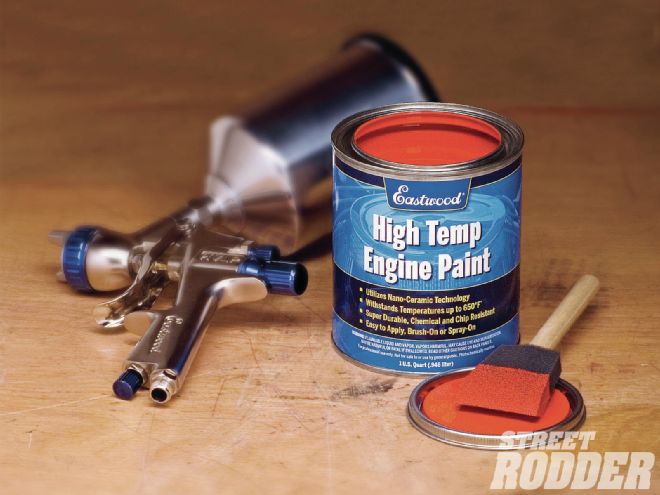 Grinding a block smooth and coating it with several coats of epoxy primer and then basecoat/clearcoat makes for a great looking motor, but all of that inhibits the heat transfer from the engine to the outside air. A couple of coats of good engine enamel paint, such as Eastwood, are all you really need.
Grinding a block smooth and coating it with several coats of epoxy primer and then basecoat/clearcoat makes for a great looking motor, but all of that inhibits the heat transfer from the engine to the outside air. A couple of coats of good engine enamel paint, such as Eastwood, are all you really need.
Finally, providing a place for the hot air to exit is imperative for a good cooling system. Louvers in the inner fender panels or the hood itself will go a long way to exiting that heated air. The more air you can pass through the radiator and around the motor the more heat will be removed.
If you are experiencing overheating problems now is the time to look at upgrading one or more of your cooling systems, or at least give the system a full maintenance. In one afternoon you should be able to inspect and do a thorough maintenance on your cooling system. Check fan belt tensions, fan belt conditions, pulley alignment, all hoses and connections for signs of wear or leaks, and then clean all components inside and out. A day in the garage should provide you with a trouble-free cooling system for your next season of street rodding.
Temperature Reduction Dynamometer Test
Controlled engine dyno tests were used to measure reduction in engine operating temperature. These dyno tests were conducted using a 350ci Chevy engine with an aluminum block and cylinder heads. The engine was run at 4,500 rpm until stabilized coolant temperature was achieved. Of course in non-controlled situations results may vary.
Coolant Mixture Stabilized Coolant Temperature Straight Water (with no corrosion protection) 221 degrees F Water with AMSOIL Inc. Dominator Coolant Boost 202 degrees F
Questions and Answers:
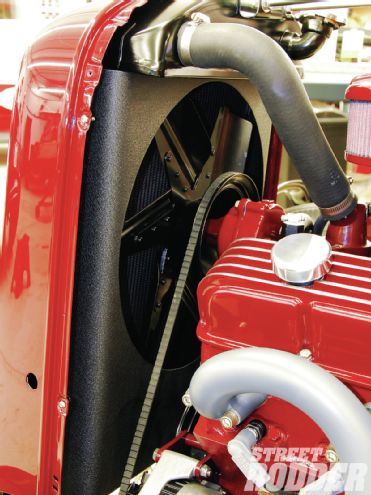 It is still entirely possible to cool a hot rod with a motor-mounted fan, but it is imperative to have a good shroud, and the fan should be mounted in the center of the radiator. This fabricated shroud works well.
It is still entirely possible to cool a hot rod with a motor-mounted fan, but it is imperative to have a good shroud, and the fan should be mounted in the center of the radiator. This fabricated shroud works well.
What are the AMSOIL INC. recommendations when using straight water coolant?
When using straight water as a coolant, the most robust form is softened water because the softening process removes impurities and minerals from the water by exchanging them for more beneficial minerals. Unlike distilled water, softened water will not act as an electrolyte, thereby minimizing damage from electrolysis. Although softened water is preferred, Dominator Coolant Boost contains an advanced formula that allows use of low-quality water (i.e. well water in cooling systems without concern of damage or scale/deposit buildup). Distilled water is not recommended in straight water systems.
For long storage periods, should the coolant be drained and the system left dry?
No. AMSOIL INC. Dominator Coolant Boost provides long-term corrosion protection. Dominator Coolant Boost contains a premium ingredient that chemically removes dissolved oxygen from any type of coolant, reducing the possibility of corrosion.
How does Dominator Coolant Boost prevent electrolysis and galvanic corrosion?
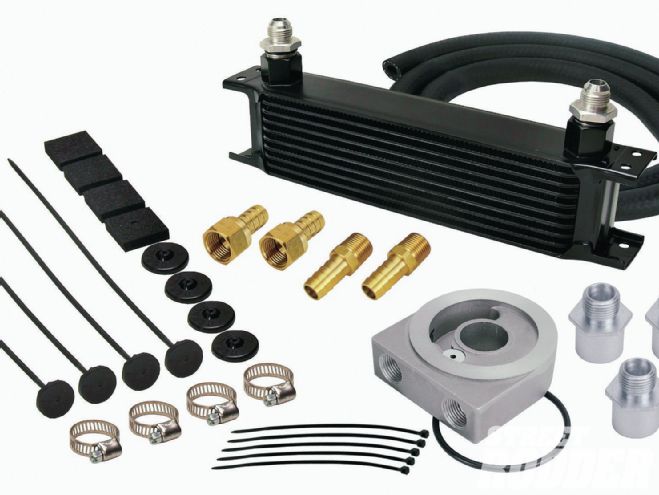 Much like the antifreeze coolant the best way to keep your oil cool is by using a remote oil cooler, such as this Derale unit. This will help maintain engine temperature and keep the lubricant working in the optimum temperature range.
Much like the antifreeze coolant the best way to keep your oil cool is by using a remote oil cooler, such as this Derale unit. This will help maintain engine temperature and keep the lubricant working in the optimum temperature range.
Galvanic corrosion occurs when antifreeze acts as an electrolyte between dissimilar metals in cooling systems. Dominator Coolant Boost contains a premium ingredient called molybdate, which forms a film on the surface of aluminum, controlling the transfer of electrons. This film helps minimize the tendency for electrolysis and galvanic corrosion.
Is Dominator Coolant Boost compatible with stop-leak additives?
There are no known compatibility issues between Dominator Coolant Boost and stop-leak additives; however, AMSOIL INC. does not recommend using stop-leak products with AMSOIL INC. coolant products.
Is Dominator Coolant Boost compatible with all types of antifreeze?
Dominator Coolant Boost is compatible with all types of antifreeze, including ethylene glycol and propylene glycol. When using a 50/50 antifreeze/water solution, AMSOIL INC. Antifreeze & Coolant (ANT) is recommended.